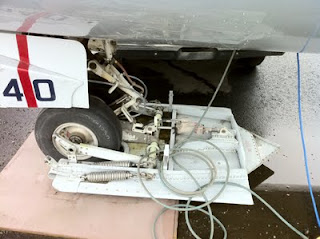The next day was spent with family in Portland. If there was any doubt about possible culture shock the evening before, today confirmed it beyond a shadow of a doubt. After walking off some outstanding German panckes for breakfast, we walked the Ladds addition and met two of my cousins, uncle and aunt, spouses, and a room full of little kids to catch up. We had a delightful lunch, hosted by my cousin's wife. The call of the wild at Watson Lake was faraway, indeed.
 |
| One last DeHavilland spotting, Starks Twin Oaks |
As we set up to leave Starks it was late afternoon. A quick call check weather at home (Watsonville, CA) revealed fog already close to minimums to fly an instrument approach and see the airport. The best approach we have, a localizer, allows a pilot to get down to about 600 feet above the ground, and the summertime fog that usually rolls in during the late evening is often below that.. By the time we got there, three-plus hours from now, there was almost no chance of making it in without a diversion. The summer of 2011 had been a pervasive one as far as the fog was concerned and it showed no signs of abating. For those unfamiliar, September, October, and November are usually the best months to visit the California coast, with the exception of 2011!).
With a diversion assured, it was now time to think of a plan B. I'd had one in the back of my mind already. Trinity Center, in the mountains west of Redding, offers the flyer a peaceful lakeside airport adjacent a warm reservoir of clean water, a peaceful place to camp, and a small community nearby. I'd stopped once before for the evening on a trip north out of curiosity rather than necessity and enjoyed it; I wanted my wife to have a look. There should be just enough daylight to get there by sunset, a necessity as the airport is unlit and in a mountainous area. Its a daytime-only field for sure.
Loaded and fueled once more, we departed for Trinity Center. In contrast to the clear skies over the Puget Sound the day before, there was now a fair amount of smoke from fires burning in the Cascades to deal with as we proceeded down the Willamette valley. It wasn't pretty down low, and the visibility was certainly questionable VFR from 8,000 to well over 11,000', and quite smelly as well. We finally got completely on top of the smoke around 12,000' and cruised south at 13,500' where the air was smooth and clear.
On almost every trip I take to or from the northwest, there is usually some kind of weather change around the California/Oregon border over the Siskiou mountains. This is usually where weather systems get ripped apart leaving California warm, and the Oregon mountains under cloud, precipitation, and icing aloft. Today, the weather was great, but just like magic, the smoke ended as we got to the Siskious. The familiar sights of Mt. Ashland where I'd learned how to ski, Mt. Shasta, Scott Valley, and finally the Trinity Alps greeted our return to California. I delayed descent over the mountains as the sun was now setting, electing to make a few circles over Trinity reservoir, adjacent the airport. We landed with perhaps another 10 minutes of light sufficient to land given the terrain and unlit field.
Pitching our tent in the fading twilight on the ramp next to a picnic table, an SUV drove onto the field. Inside was a gentleman who upheld Trinity Center's reputation as a very hospitable place to visit. He lived in a house further down the field and decided to drive over just to see if we needed anything. He ended up inviting us over for breakfast the next day. During my last visit to Trinity, a family was picking up their son who flew in about the same time as me. They returned in the evening to invite me for breakfast at their home. Here I was, for the second time, invited to a stranger's house for breakfast! Its hard to beat that. Our evening was pleasant - quiet, warm, and with a sky full of stars to feast upon.
The next morning, after a brief swim in the lake, we made our way to our new friend's house for breakfast. He was a retired M.D., who had previously owned several airplanes and had taken several trips to Alaska. Naturally, we had plenty in common to discuss.
"After I got back from Alaska, there was a medial convention in Brazil I was planning to attend", he remarked. "I told my father I was going to buy an airline ticket and he said 'Why not just fly down yourself? You just flew to Alaska and back'." So with that, he flew to Brazil, in the 1960s, in his twin-engine Piper.
After lingering a while we began our last leg of the trip. It seemed apropos to say goodbye to our new friend with a low approach down the runway, but a couple of crows circling near the runway's end kept me from descending as much as I would have otherwise. The way home was positively routine. Light wind, warm atmosphere, California sunshine...all the way to the fog-laden coast, anyway. The fog was just starting to break when we arrived. I requested an IFR clearance to fly a localizer approach, broke out, circled to land, and touched down nonchalantly, as if from any other flight in the local area.
We called my brother in law, who had graciously come to house-and-dog sit for us while working remotely, to pick us up. While waiting, my wife ran into a man I used to work with (outside of aviation) for several years. He had just come down to the airport at random to take a look.
"Where did you come from?" He asked. "Well", I said, "Alaska."











































